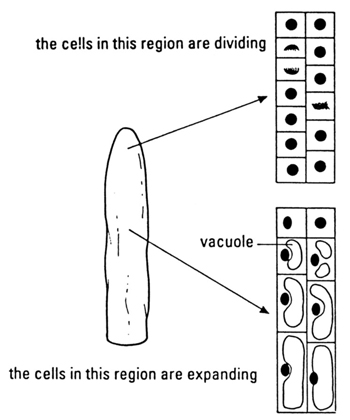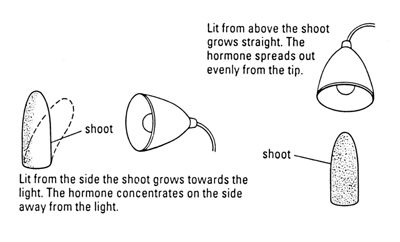Interpreting an investigation of plant hormones
Class exercise
This is a paper exercise, with a presentation on the student sheet of a classic investigation for the students to interpret.
Lesson organisation
The questions are quite testing.
You could require written answers, or use this as a group discussion exercise. Perhaps you could lead the discussion of the first two investigations to establish some of the key ideas, and then allow separate groups to discuss and present their own ideas about the results of investigations 3, 4 and 5.
Apparatus and Chemicals
For each group of students:
![]() Student sheet with questions and answers (1.1 MB) as handout.
Student sheet with questions and answers (1.1 MB) as handout.
Health & Safety and Technical notes
Procedure
Present the investigation as described on the student sheet.
Discuss the investigative method and its results. Make any appropriate conclusions.
Teaching notes
This diagram shows where in the shoot tip cell division and growth is happening.

The tip of the coleoptile is the part that responds to light. Covering the tip with foil does not stop growth, but it stops the reaction to light. It looks as if growth in the region just behind the tip is what makes the shoot bend. Cells divide to make more cells in the tip itself. The cells that grow bigger are in the region below the tip.
- Cutting off the tip and replacing it shows that something produced in the tip is influencing the cells further down the shoot.
- The substance produced in the tip is a chemical that can diffuse through plant tissue or into agar gel. When you cut the tip off, the chemical is still produced and is collected in the agar gel. The chemical then moves out of the gel into the shoot and stimulates growth again. It could be called a ‘growth hormone’.
- The fact that gel works on its own indicates it is not an electrical message like * the messages carried by nerves in animals.
- The chemical messenger can travel through gel, but not a sheet of metal.
- The reactions in the other investigation are not caused by the agar. Fresh agar does not cause a shoot to bend. Something in the other agar (absorbed from a fresh shoot tip) is making the shoot bend, because the cells underneath the jelly grow more than those on the other side.
- Normally the tip produces a hormone that spreads down to the cells below. The cells grow evenly all around the shoot and the shoot grows straight up.
- When lit from one side, growth is faster on the side away from the light. For some reason, the concentration of hormone is less on the light side (or more on the dark side). The part of the shoot on the side away from the light grows more, so the shoot bends towards the light.

The article by Richard D Firn and John Digby (linked below) could provide an interesting starting point for higher level investigations. It could also help students to understand that, even when a scientific theory is presented and accepted, there can still be more questions to answer and more work to do. This provides an interesting extension for exploring How Science Works.
Downloads
Download the student sheet ![]() Interpreting an investigation of plant hormones (1.1 MB) with questions and answers.
Interpreting an investigation of plant hormones (1.1 MB) with questions and answers.
Web links
www.epress.com/w3jbio/vol7/firn/index.html
This article by Richard D Firn and John Digby on the World Wide Web Journal of Biology, shows that there are still questions to be asked (and answered) about tropisms. This, and other articles by the same author, suggest that the existing theory does not explain the full range of responses (to light and gravity) shown by plants, but only part of the initial responses of young shoots and roots.
(Website accessed October 2011)


